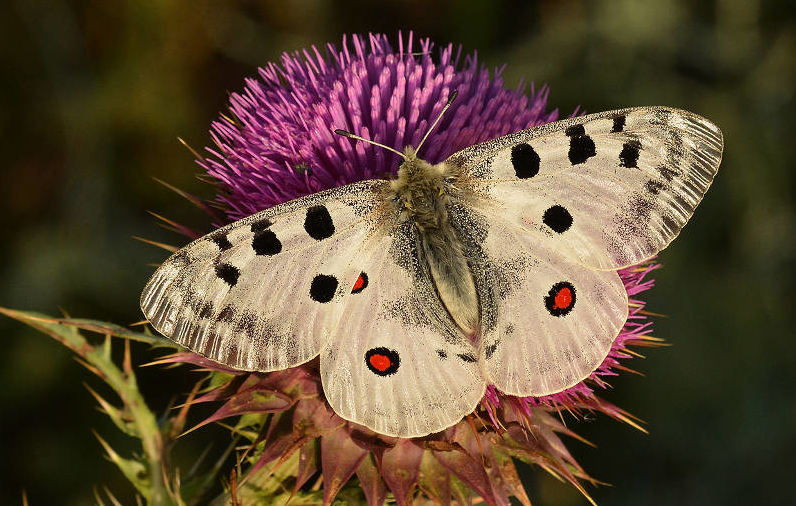Apollo
Parnassius apollo
Checklist Number56.001 [B&F: 1536]
Verification
Record will require further evidence, at least a good photograph, unless CMR is aware recorder has confidence in identification
Classification
| Family: | Papilionidae |
| Subfamily: | Parnassiinae |
| Genus: | Parnassius |
| Species: | apollo |
| Authority: | (Linnaeus, 1758) |
A very occasional visitor (or deliberate release) to the British Isles with 20 or so known records, from 1803 up until 1957, with latest (at the time of writing) being in 1986. The most likely populations to reach the British Isles are those originating from the mountains of Norway, ssp. jotunensis, and those from south-west Germany, and the Vosges and Jura mountains in France, ssp. melliculus.
Most authors have dismissed the majority of the records as either accidental or intentional introductions, but in particular one in 03/08/1955, taken on Folkestone Warren, Kent at a time of other migrant lepidoptera activity, and the latest on 20/08/1986, from East Kent, are regarded as good candidates for natural origin. An intriguing quote hints of a sighting in our area: "In 1865, in a boat off Sea View, I saw, for a few moments, resting on the boat, the last specimen of the Apollo butterfly seen in England. I might easily have caught it. I stopped the boatman from doing so. I knew its rarity and wished it to live. This the most beautiful of all our British butterflies, now extinct, was once common in the Isle of Wight, but building operations, and cutting down of the trees and shrubs on which the caterpillars fed made it scarce, and the "bug-hunter" did the rest - Stephen H. Terry." The last sentence however throws more than a little doubt on this sighting, as The Apollo has never been resident, let alone common, on our islands, especially as the caterpillars feed on stonecrops, not woody plants (Lanktree, P.A.D. (1960) Some Old Records of Lepidoptera, and The Last Apollo seen in England - an allegation referring to 95 years ago. Entomologist's Record and Journal of Variation.)
Wingspan 70-85 mm.
Most authors have dismissed the majority of the records as either accidental or intentional introductions, but in particular one in 03/08/1955, taken on Folkestone Warren, Kent at a time of other migrant lepidoptera activity, and the latest on 20/08/1986, from East Kent, are regarded as good candidates for natural origin. An intriguing quote hints of a sighting in our area: "In 1865, in a boat off Sea View, I saw, for a few moments, resting on the boat, the last specimen of the Apollo butterfly seen in England. I might easily have caught it. I stopped the boatman from doing so. I knew its rarity and wished it to live. This the most beautiful of all our British butterflies, now extinct, was once common in the Isle of Wight, but building operations, and cutting down of the trees and shrubs on which the caterpillars fed made it scarce, and the "bug-hunter" did the rest - Stephen H. Terry." The last sentence however throws more than a little doubt on this sighting, as The Apollo has never been resident, let alone common, on our islands, especially as the caterpillars feed on stonecrops, not woody plants (Lanktree, P.A.D. (1960) Some Old Records of Lepidoptera, and The Last Apollo seen in England - an allegation referring to 95 years ago. Entomologist's Record and Journal of Variation.)
Wingspan 70-85 mm.
